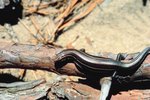
Centipedes are long, flat arthropods that belong to the class chilopoda. Their bodies are segmented and covered with a tough exoskeleton, with each segment containing a pair of legs. The pair of legs on the front is adapted to work as stinging fangs that grasp prey and deliver poison. On the rear end, the final pair of legs is also modified to act as sensing organ. Most centipedes are predators and can only be identified by their colors, pair of legs and habitat.
House Centipedes
House centipedes are generally yellowish brown in color and belong to the order scutigeromorpha. Originally they originated from the Mediterranean region but currently can be found all over the world. Unlike the other species of centipedes, the bodies of house centipedes are a distinctive shape, with a body length of approximately 1 inch long with up to 15 pairs of long, barbed legs. They are commonly found in homes in dark or damp areas like bathrooms, ceilings, walls, sinks and lavatories and are insectivorous. They feed on cockroaches, flies, moths, silverfish and spiders. Thus, they can be considered beneficial to human by controlling pests in the house. Occasionally, they might bite humans, but their bite is not that dangerous.
Giant Centipedes
Giant centipedes are one of the largest species of centipedes in the world. Also known as Scolopendra heros, giant centipedes have 23 pairs of legs. Similar to other centipedes they are flat bodied with poisonous claws on their forelegs. They have black heads and rears with bright yellow bodies and limbs. However, some of the species may have red heads and black bodies. These colors clearly indicate that this type of centipedes is poisonous. However, they are poorly sighted and mostly rely on their antennas to locate prey. Mostly, they are found in rocky and desert regions in northern Mexico and the United States.
Stone Centipedes
Stone centipedes belongs to the order lithobiomorpha. They have flattened bodies that allow them to maneuver in tiny spaces. They all have 15 pairs of legs and a length of approximately 2 inches. Like desert centipedes they are poorly sighted and can only sense their prey by touch. They are common in temperate regions of Australia and the United States under rocks and logs.
Fire Centipedes
Well known for their attractive reddish hard exoskeleton, fire centipedes are capable of spitting a poisonous bioluminescent chemical substance. They have 20 to 40 pairs of sharp-edged legs -- the number of legs depends on the size. Fire centipedes are mostly found in subtropical regions of Africa and Asia and are predators just like other centipedes.
References
Photo Credits
-
Brand X Pictures/Brand X Pictures/Getty Images
Writer Bio
Kendal Elizabeth has been a professional writer and editor since 2001. She has specialized in writing pet-related topics, home decor and gardening. Her work has appeared on several online and offline publication. Elizabeth holds a Bachelor of Science in Animal Science with a minor in marine biology from Cornell University.



